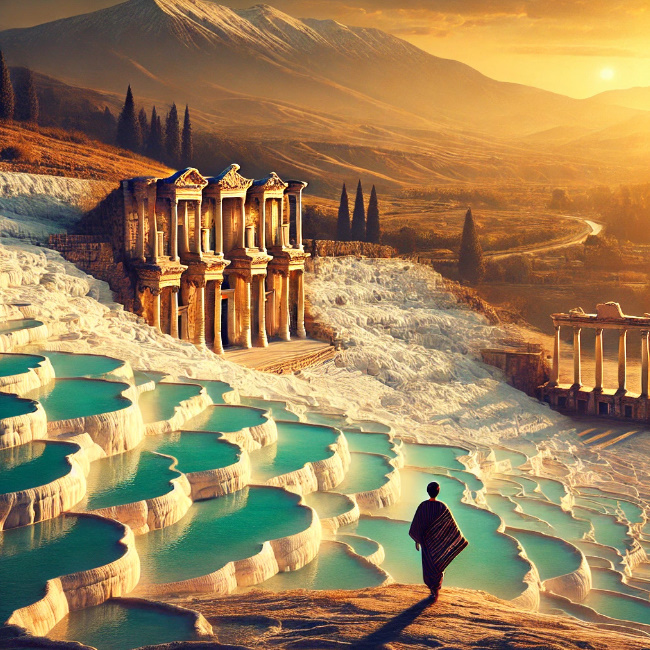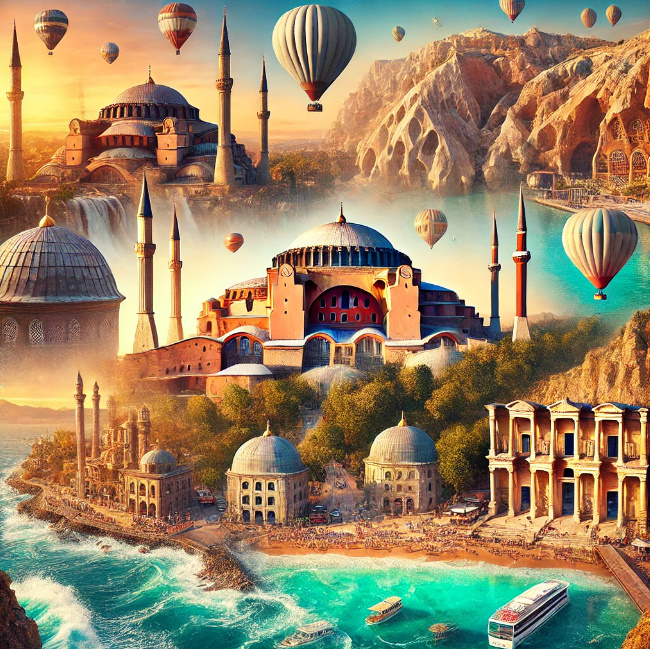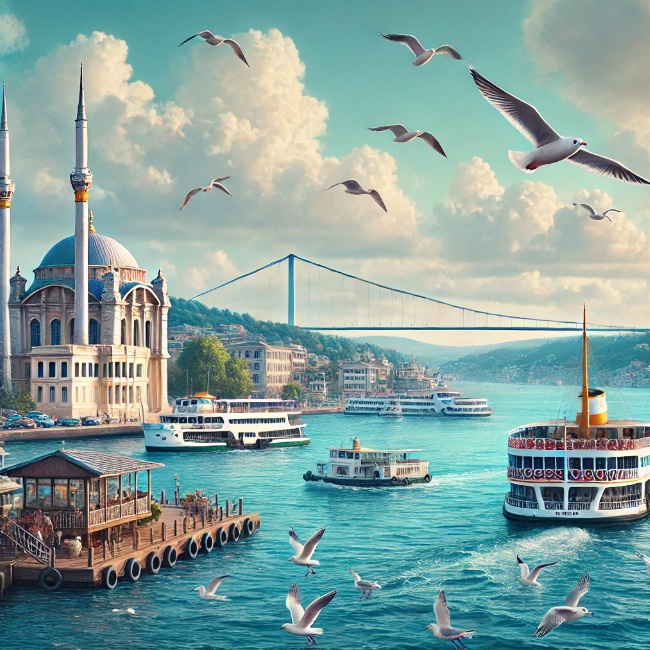Pamukkale, meaning “Cotton Castle” in Turkish, is one of Turkey’s most breathtaking natural wonders. The white travertine terraces, filled with turquoise thermal waters, create an otherworldly landscape that looks like something out of a dream.
Located next to Pamukkale, Hierapolis is an ancient Greco-Roman city, home to stunning ruins, a grand amphitheater, and sacred hot springs that have been attracting visitors for thousands of years. Together, Pamukkale and Hierapolis offer a magical combination of history, culture, and natural beauty.
📍 Top Attractions in Pamukkale & Hierapolis
1️⃣ Pamukkale Travertine Terraces – The Cotton Castle
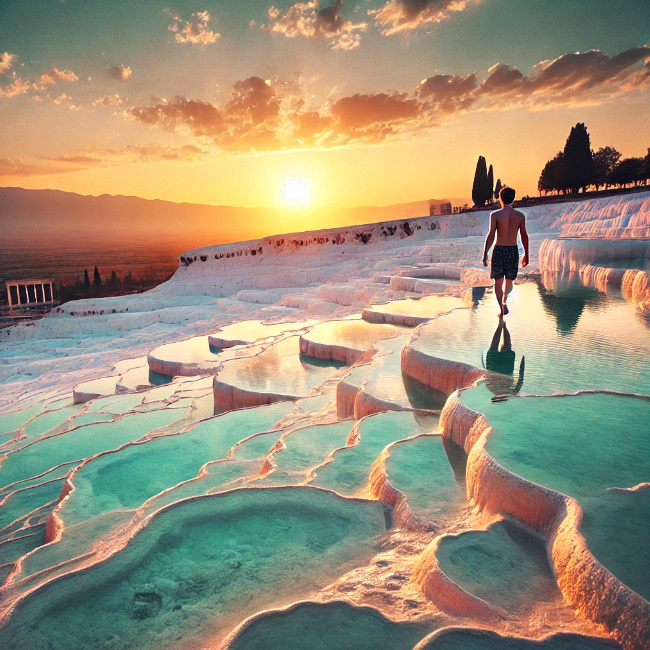
🌊 Must-See Attractions:
- White Travertine Pools – Step into natural thermal pools formed over thousands of years.
- Sunset at Pamukkale – The most stunning time to witness the glowing terraces.
- Thermal Water Foot Bath – Enjoy a natural spa experience in warm mineral-rich waters.
♨ Why It’s Special? The calcium-rich waters flowing from underground springs create unique white limestone formations, making it one of the most famous landscapes in the world.
📷 Photo Opportunity: A person standing barefoot in the thermal pools, overlooking the sunset
2️⃣ Hierapolis Ancient City – The Healing City of the Romans
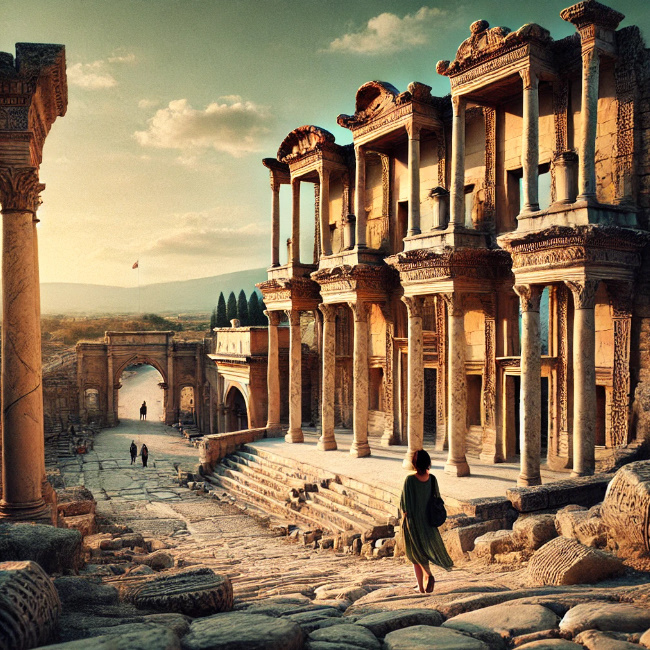
🏛 Must-See Attractions:
- Hierapolis Theatre – A stunning, well-preserved Roman amphitheater with breathtaking views.
- Temple of Apollo – The spiritual center of Hierapolis.
- Nymphaeum (Sacred Fountain) – An ancient fountain dedicated to water nymphs.
- Hierapolis Necropolis – One of the largest ancient cemeteries in the world.
🕰 Historical Fact: Hierapolis was a Roman spa city where people from all over the empire came for healing and relaxation.
📷 Photo Opportunity: The ancient theater with rolling hills in the background
3️⃣ Cleopatra’s Pool – Swim in an Ancient Thermal Spa
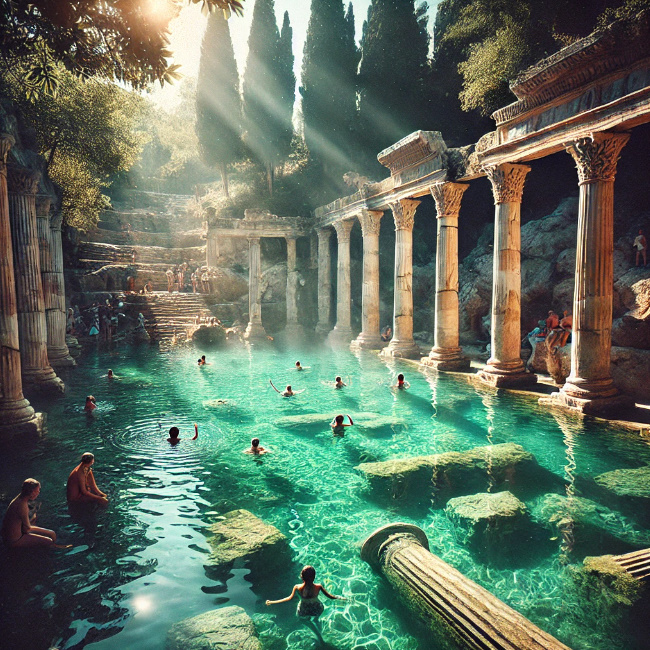
♨ Why Visit?
- Swim among ancient Roman columns in a warm, mineral-rich natural hot spring.
- The water is believed to have healing properties for the skin and joints.
- It’s said that Cleopatra herself bathed here for beauty and relaxation.
🏊 Tip: Don’t miss the bubbles rising from the thermal spring, creating a jacuzzi-like effect!
📷 Photo Opportunity: A swimmer floating next to ancient columns submerged in the clear waters
4️⃣ Pamukkale Natural Park & Lake
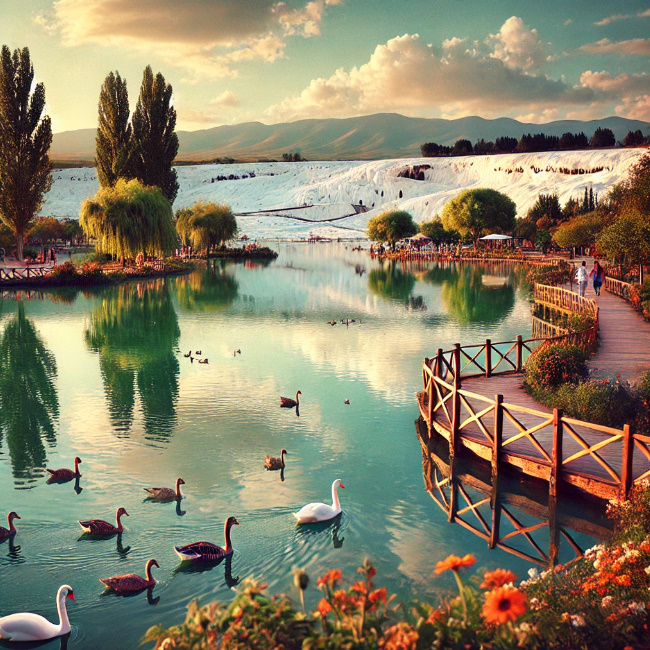
🌿 Why Visit?
- A beautiful park and lake at the base of the travertines.
- You can see ducks, swans, and turtles while enjoying a picnic.
- Perfect for a quiet break after exploring the terraces.
🥤 What to Try? Freshly squeezed pomegranate juice from one of the local stalls.
📷 Photo Opportunity: The reflection of the white terraces in the turquoise lake
5️⃣ Kaklık Cave – The Underground Pamukkale
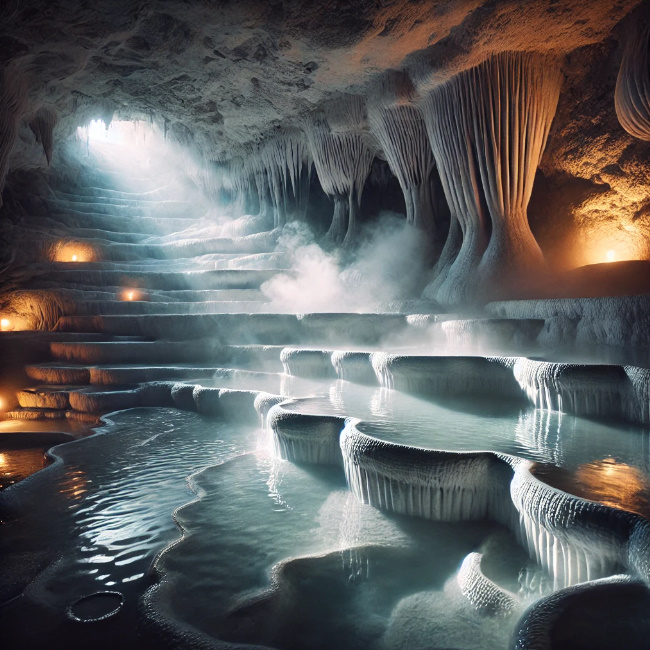
⛰ Why Visit?
- A hidden gem often called “Pamukkale’s Underground Twin”.
- Features small travertine terraces and thermal pools inside a cave.
- A great place for those who want a unique off-the-beaten-path experience.
📷 Photo Opportunity: Sunlight filtering into the cave, illuminating the turquoise waters
🏞 Best Natural Wonders in Pamukkale & Hierapolis
- Beyaz Su (White Water) – A natural stream with milky-white mineral water.
- Karahayıt Hot Springs – Known for its red-colored thermal waters due to iron deposits.
- Laodicea Ancient City – Just 15 km away, featuring Roman ruins and an amphitheater.
- Denizli Cable Car (Bağbaşı Plateau) – A scenic ride offering panoramic views of Pamukkale.
🍽 What to Eat in Pamukkale & Denizli
✅ Kuyu Kebabı – A slow-cooked lamb dish famous in Denizli.
✅ Denizli Tandır – A delicious roast meat dish, perfect with fresh bread.
✅ Gözleme – A crispy Turkish stuffed flatbread.
✅ Pide (Turkish Pizza) – A local favorite topped with cheese, meat, or vegetables.
✅ Şam Tatlısı – A syrupy semolina dessert unique to Denizli.
🚆 How to Get to & Around Pamukkale
✈ By Air: The nearest airport is Denizli Çardak Airport (DNZ), 65 km from Pamukkale.
🚆 By Train: The Denizli Train Station connects Pamukkale with other major cities in Turkey.
🚌 By Bus: There are direct buses from Istanbul, İzmir, and Antalya to Denizli.
🚗 By Car: Renting a car is the best way to explore nearby attractions like Laodicea and Karahayıt Hot Springs.
🌦 Best Time to Visit Pamukkale & Hierapolis
🌸 Spring (March–May): Ideal for mild weather and blooming flowers.
☀ Summer (June–August): Best for hot air balloon rides but can be very hot.
🍂 Autumn (September–November): The best time for warm but comfortable weather.
❄ Winter (December–February): A magical time to see snow-covered travertines.
🕰 Opening Hours: Pamukkale & Hierapolis are open from sunrise to sunset.
🇹🇷 Turkish Culture & Etiquette in Pamukkale
✅ Respect the travertine terraces – Walk barefoot to protect the delicate formations.
✅ Bring a swimsuit if you plan to swim in Cleopatra’s Pool.
✅ Avoid midday visits in summer – The terraces get very hot under the sun.
✅ Support local vendors by trying fresh fruit juices and handmade souvenirs.
✅ Be prepared for walking – Wear comfortable shoes for exploring Hierapolis.
✨ Why Visit Pamukkale & Hierapolis?
Pamukkale is one of the most unique landscapes in the world, while Hierapolis takes you back in time to an ancient spa city. Whether you’re bathing in Cleopatra’s Pool, exploring ancient ruins, or taking in the beauty of the white terraces, this is a once-in-a-lifetime experience you won’t forget!
🇹🇷 İyi yolculuklar! (Safe Travels!) ✨
Would you like a custom itinerary for your trip? Let me know your preferences! 😊
Absolutely! Here’s your Cappadocia Travel Guide FAQ 🇹🇷🎈🏜️—covering hot air balloons, cave hotels, best time to visit, and must-see attractions for an unforgettable adventure in Turkey’s magical landscape!
🎈 Cappadocia Travel Guide: FAQ 🇹🇷
Your ultimate guide to exploring Turkey’s fairy-tale destination!
✈️ Getting to Cappadocia
1️⃣ What airport do I fly into?
✅ Nevşehir Kapadokya Airport (NAV) – 40 minutes from Göreme
✅ Kayseri Erkilet Airport (ASR) – 1-hour drive, more flight options
💡 Kayseri (ASR) has more direct flights from Istanbul & other cities!
2️⃣ How do I get from the airport to my hotel?
🚐 Shuttle Buses: €10–€15 per person (pre-book with hotel)
🚖 Private Transfer: €50–€70
🚗 Car Rental: €30–€50 per day (good if you plan to explore independently)
💡 Most hotels offer airport transfers—check before booking!
🏨 Where to Stay in Cappadocia?
3️⃣ What are the best areas to stay?
- Göreme – Best for first-timers, close to attractions & hot air balloons
- Uçhisar – Luxury cave hotels, panoramic views
- Ürgüp – More modern, upscale restaurants & wineries
- Avanos – Peaceful, famous for pottery workshops
💡 Göreme is the most popular and best for budget & mid-range travelers!
4️⃣ What are the best hotels in Cappadocia?
✅ Luxury Cave Hotels
- Argos in Cappadocia (Uçhisar) 💰 €400+
- Museum Hotel (Uçhisar, 5-star with amazing views) 💰 €500+
✅ Mid-Range
- Sultan Cave Suites (Göreme, rooftop balloon views!) 💰 €150+
- Kelebek Cave Hotel (Göreme, Turkish bath & pool) 💰 €130+
✅ Budget-Friendly
- Terra Cave Hotel (Göreme, authentic & cozy) 💰 €70+
- Sakura Cave Hotel (Ürgüp, family-run, great value) 💰 €50+
💡 Book early, especially in peak season (April–October)!
🚗 Getting Around Cappadocia
5️⃣ Do I need a car in Cappadocia?
✅ Not necessary if you book tours, but good for independent exploring
- Taxis & tours: Easy & common
- Scooters & ATVs: Great for short distances (€30–€50 per day)
- Public transport: Limited, but minibuses connect towns
💡 Rent a car or book a guided tour for day trips!
🎈 What To Do in Cappadocia
6️⃣ What are the must-see attractions?
- Hot Air Balloon Ride 🎈 (The highlight of Cappadocia!)
- Göreme Open-Air Museum 🏛️ (Ancient cave churches with frescoes)
- Uçhisar Castle 🏰 (Best panoramic view!)
- Love Valley 💕 (Famous rock formations, great for hiking)
- Derinkuyu Underground City 🏚️ (Ancient tunnels & chambers)
- Pasabag (Monks Valley) 🏜️ (Fairy chimneys & rock formations)
- Avanos Pottery Workshops 🎨 (Try making your own pottery!)
💡 Many attractions are free or included in tours!
7️⃣ How much does a hot air balloon ride cost?
💰 €150–€300 per person (Varies by season & company)
🕐 Duration: ~1 hour flight (hotel pickup at 4–5 AM)
💡 Book early—flights sell out fast!
🚀 Best Companies:
✅ Royal Balloon
✅ Butterfly Balloons
✅ Turquaz Balloons
💡 Balloon flights are weather-dependent—have a backup day in case of cancellations!
🏜️ Best Tours & Activities
8️⃣ What are the best tours in Cappadocia?
🚗 Red Tour (North Cappadocia) – €50–€80
- Göreme Open-Air Museum, Love Valley, Uçhisar Castle
🏜️ Green Tour (South Cappadocia) – €70–€100
- Derinkuyu Underground City, Ihlara Valley hike, Selime Monastery
🚲 ATV Sunset Tour – €40–€60
- Ride through Rose Valley & Love Valley
🐴 Horseback Riding (‘Sunset Safari’) – €50
💡 Book tours through your hotel for convenience!
🍽️ Food & Drink in Cappadocia
9️⃣ What food is Cappadocia famous for?
- Testi Kebabı 🍲 (Slow-cooked meat stew in a clay pot—cracked open at your table!)
- Manti 🥟 (Turkish dumplings with yogurt sauce)
- Gözleme 🫓 (Savory stuffed flatbread)
- Sütlaç 🍮 (Rice pudding, popular dessert)
🔟 Best Restaurants in Cappadocia?
✅ Seten Restaurant (Göreme) – Romantic cave dining
✅ Ziggy Cafe (Ürgüp) – Great terrace views & meze platters
✅ Pumpkin Göreme Restaurant – Cozy, homemade Turkish dishes
💡 Try Turkish tea or Cappadocia wines (Ürgüp has great wineries)!
🌤️ Best Time to Visit Cappadocia
1️⃣1️⃣ When’s the best time to go?
✅ Spring (April–June) 🌸 – Mild weather, green landscapes
✅ Autumn (September–November) 🍁 – Less crowded, perfect for hiking
🚫 Summer (July–August) ☀️ – HOT & busy
✅ Winter (December–February) ❄️ – Snow-covered fairy chimneys, magical!
💡 Balloon flights run year-round, but best conditions are in spring & autumn!
💰 Budget & Costs
1️⃣2️⃣ How expensive is Cappadocia?
- Budget Traveler: €40–€80/day
- Mid-Range: €100–€200/day
- Luxury: €250+/day
💡 Street food, public transport & guesthouses make Cappadocia very budget-friendly!
🛡️ Safety in Cappadocia
1️⃣3️⃣ Is Cappadocia safe for tourists?
✅ Yes! One of the safest places in Turkey
- Low crime rates, but watch out for tourist scams (overpriced taxis)
- Hiking is safe, but use maps & bring water!
📞 Emergency number: 112
📱 Wi-Fi & SIM Cards
1️⃣4️⃣ How do I stay connected in Cappadocia?
✅ Free Wi-Fi in hotels & restaurants
📱 Turkish SIM Cards: Buy from Turkcell, Vodafone, or Türk Telekom
💡 eSIM options available!
✅ Quick Tips for Visiting Cappadocia
✔️ Book hot air balloon rides & hotels EARLY!
✔️ Wear layers (mornings are cold, afternoons hot!)
✔️ Use Istanbulkart for bus transfers from airports
✔️ Bring a power bank for long day tours
✔️ Try local pottery workshops & wine tasting!
✔️ Always carry cash—some places don’t take cards
✅ How to Save This FAQ as a PDF
- Copy this FAQ into Google Docs or Microsoft Word
- Click File → Download → PDF Document (.pdf)
- Done! Your Cappadocia Travel FAQ PDF is ready! 🎈✨
Need help with custom itineraries, balloon booking tips, or best hiking trails? Just ask! 😊
Absolutely! Here’s your Pamukkale & Hierapolis Travel Guide FAQ 🇹🇷💦🏛️ — covering how to get there, best time to visit, must-see spots, and practical tips for exploring Turkey’s “Cotton Castle” and its ancient ruins!
🇹🇷 Pamukkale & Hierapolis Travel Guide: FAQ 💦🏛️
Your complete guide to Turkey’s stunning white terraces and ancient Roman city!
✈️ Getting to Pamukkale & Hierapolis
1️⃣ What’s the nearest airport to Pamukkale?
✅ Denizli Çardak Airport (DNZ) – 65 km (~1-hour drive to Pamukkale)
💡 No direct flights from abroad—fly to Istanbul (IST/SAW) and then take a domestic flight to Denizli.
2️⃣ How do I get to Pamukkale from Istanbul, Antalya, or Izmir?
🚆 From Istanbul:
- Flight to Denizli (1 hour, ~€30–€80) + shuttle (1 hour, €5–€10)
- Overnight bus (10–12 hours, €15–€25)
🚆 From Antalya:
- Bus (4–5 hours, €10–€15)
- Private transfer (€100+)
🚆 From Izmir:
- Train to Denizli (3.5 hours, €5)
- Bus (4 hours, €10)
💡 The easiest way is to fly from Istanbul to Denizli and take a shuttle to Pamukkale!
🏨 Where to Stay in Pamukkale?
3️⃣ What are the best areas to stay?
- Pamukkale Village – Budget-friendly, walking distance to the terraces
- Karahayıt – Known for red thermal waters, quieter, more local vibe
- Denizli City – Bigger hotels, 20-minute drive from Pamukkale
💡 Most travelers stay in Pamukkale Village for convenience!
4️⃣ What are the best hotels in Pamukkale?
✅ Luxury & Thermal Resorts
- Doga Thermal Health & Spa 💰 €150+ (Karahayıt, great for wellness)
- Richmond Pamukkale Thermal Hotel 💰 €120+ (5-star spa hotel)
✅ Mid-Range
- Venus Suite Hotel 💰 €60+ (Best-rated boutique hotel, great location)
- Melrose House Hotel 💰 €50+ (Friendly, family-run)
✅ Budget-Friendly
- Hotel Sahin 💰 €30+ (Rooms with terrace views of Pamukkale)
- Cotton House Hotel 💰 €25+ (Basic but great value)
💡 Book early for spring & autumn—hotels fill up fast!
🚶♂️ Exploring Pamukkale & Hierapolis
5️⃣ What are the must-see attractions in Pamukkale?
- White Travertine Terraces 💦 (Walk barefoot on the thermal pools)
- Hierapolis Ancient City 🏛️ (Greek-Roman ruins above Pamukkale)
- Cleopatra’s Pool 🏊 (Swim among ancient columns in mineral-rich waters)
- Hierapolis Theatre 🎭 (Well-preserved amphitheater with epic views)
- Antique Pool & Roman Baths ♨️ (Thermal spa ruins)
💡 Most people spend 3–5 hours exploring the site.
6️⃣ How much is the entrance fee to Pamukkale & Hierapolis?
💰 Entrance Fee: ~€15 (covers Pamukkale & Hierapolis)
💰 Cleopatra’s Pool: Extra €8 (~300 TL) to swim
🕐 Opening Hours:
- Summer: 06:30 AM – 9:00 PM
- Winter: 08:00 AM – 6:00 PM
💡 Mornings & sunset are best for avoiding crowds & extreme heat!
7️⃣ Can I swim in Pamukkale’s travertine pools?
✅ Yes, but only in designated pools—some terraces are protected.
🚫 No shoes allowed inside the travertine area!
💡 Cleopatra’s Pool is the best place to swim among ancient Roman ruins!
8️⃣ Best way to explore Pamukkale & Hierapolis?
✅ Self-guided walk (start from the South Gate, end at the town)
✅ Guided tour (€30–€60, includes history & hidden spots)
✅ Paragliding (€50–€80, fly over the terraces!)
💡 Most visitors spend half a day, but history lovers may want a full day.
🌤️ Best Time to Visit Pamukkale
9️⃣ When’s the best time to visit?
✅ Spring (March–May) 🌸 – Green landscapes, mild weather
✅ Autumn (September–November) 🍂 – Fewer crowds, cooler temps
🚫 Summer (June–August) ☀️ – Very hot (35–40°C), crowded
✅ Winter (December–February) ❄️ – Peaceful, warm thermal pools, but some pools may be dry
💡 Go early (before 9 AM) or for sunset (after 5 PM) to avoid crowds!
🍽️ Food & Drink in Pamukkale
🔟 What food is Pamukkale known for?
- Kuzu Tandir 🍖 – Slow-cooked lamb (Denizli specialty)
- Gözleme 🫓 – Traditional Turkish stuffed flatbread
- Pide 🍕 – Turkish-style pizza
- Denizli Rooster Kebab 🐓 – Local grilled chicken specialty
- Turkish Tea & Baklava 🍵🍯 – Perfect after a long day of exploring!
🍽️ Best Restaurants in Pamukkale
✅ Kayas Wine House – Best local wines & Turkish dishes
✅ White House Restaurant & Cafe – Great pide & home-cooked food
✅ Asian Kitchen Landscape – Good mix of Turkish & international options
💡 Avoid overpriced tourist restaurants near the entrance gates!
🏜️ Nearby Attractions & Day Trips
1️⃣1️⃣ What are the best day trips from Pamukkale?
✅ Laodicea Ancient City 🏛️ (15 km) – Less crowded Roman ruins
✅ Aphrodisias 💕 (100 km) – Stunning ancient city dedicated to the goddess of love
✅ Salda Lake 💦 (120 km) – Known as “Turkey’s Maldives” for its white sand & blue water
💡 Aphrodisias is a MUST if you love history!
💰 Budget & Costs
1️⃣2️⃣ How expensive is Pamukkale?
- Budget Traveler: €30–€50/day
- Mid-Range: €80–€150/day
- Luxury: €200+/day
💡 Many attractions are free or cheap—biggest costs are hotels & hot air balloons!
🛡️ Safety in Pamukkale
1️⃣3️⃣ Is Pamukkale safe for tourists?
✅ Yes! It’s a very safe destination
- Pickpocketing is rare, but watch for overpriced taxis & tourist scams
- Bring sunscreen & water—heat can be intense in summer
📞 Emergency number: 112
📱 Wi-Fi & SIM Cards
1️⃣4️⃣ How do I stay connected in Pamukkale?
✅ Wi-Fi is available in hotels & cafes
📱 SIM cards: Get Turkcell, Vodafone, or Türk Telekom at Denizli Airport
💡 Some areas in Hierapolis have weak signals—download maps in advance!
✅ Quick Tips for Visiting Pamukkale
✔️ Wear sunglasses & sunscreen—the white terraces reflect a LOT of sunlight!
✔️ Go early or late to avoid crowds & heat
✔️ Bring a swimsuit for Cleopatra’s Pool
✔️ Don’t wear shoes in the travertines—respect the natural site
✔️ Stay overnight to enjoy a relaxed visit & sunset views
✅ How to Save This FAQ as a PDF
- Copy this FAQ into Google Docs or Microsoft Word
- Click File → Download → PDF Document (.pdf)
- Done! Your Pamukkale & Hierapolis Travel FAQ PDF is ready! 💦✨
Need custom itineraries, guided tour suggestions, or nearby destinations? Just ask! 😊
